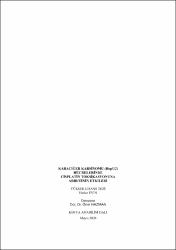| dc.contributor.advisor | Hazman, Ömer | |
| dc.contributor.author | Evin, Hatice | |
| dc.date.accessioned | 2020-10-27T07:00:30Z | |
| dc.date.available | 2020-10-27T07:00:30Z | |
| dc.date.issued | 2020 | en_US |
| dc.identifier.uri | https://hdl.handle.net/11630/8430 | |
| dc.description.abstract | Kanser tedavisinde cerrahi yaklaşım, radyoterapi ve kemoterapi yıllardan beri kullanılmaktadır. Özellikle kemoterapik tedavide kanserli hücre ve dokuların dışında kalan kısımlarda oluşan yan etkileri azaltacak kombine tedavi yöntemlerinin geliştirilmesi kanser tedavisinin başarı şansını artırmaktadır. Bu nedenle söz konusu yan etkileri azaltacak alternatif yöntemler sıkça araştırmalara konu olmaktadır. Sunulan çalışmada da bir antioksidan olarak arbutinin karaciğer karsinomu (HepG2) hücreleri üzerine olası etkileri ile bir kemoterapik ajan olan cisplatinin oluşturduğu toksikasyona karşı arbutinin HepG2 hücrelerinde etkinliğinin belirlenmesi amaçlanmıştır.
Arbutin ve cisplatinin antikanserojenik etkinlikte dozları MTT analizleri ile belirlendi. Arbutin izoformlarına ve cisplatine ait lethal lozlar (LD) belirlendikten sonra deney grupları (Grup 1: Kontrol, Grup 2:LD0 dozunda α-arbutin, Grup 3:LD50 dozunda α-arbutin, Grup 4: LD50 dozunda cisplatin Grup 5: Tedavi grubu LD50 dozunda Cisplatin + LD0 dozunda α-arbutin oluşturuldu. Deney gruplarından elde edilen numunelerde biyokimyasal olarak total antioksidan statü (TAS), total oksidan statü (TOS), oksidatif stres indeksi (OSI), proinflamatuvar stokin düzeyleri (TNF-α, IL-6 ve TGF-β1) belirlendi. Moleküler analizlerle ise DNA hasarı (comet testi ile), mikronükleus oluşumu aracılığı ile deney gruplarında yapılan uygulamaların genotoksisiteye etkisi belirlenmeye çalışıldı. Apoptozisle ilgili kaspaz 3 ve proliferasyonla ilgili Bcl-2 genlerinin mRNA ekspresyon düzeyleri RT-PCR yardımıyla analiz edildi. Ayrıca oluşturulan in-vitro modellemede yapılan uygulamaların p53 ve kaspaz3 düzeylerine etkileri immunostokimyasal yöntemlerle analiz edildi.
Sitotoksisite analizleri sonucunda α-arbutinin LD50 dozundaki sitotoksiste düzeyi β-arbutine göre daha yüksek çıktığı için çalışmalarda α-arbutin kullanıldı. Düşük doz (LD0 dozunda) α-arbutinin tek başına hepatosellüler karsinom (HepG2) hücrelerine uygulandığında herhangi bir genotoksik ve sitotoksik etkileri olmadığı, inflamasyon, apoptoz ve proliferasyonu etkilemediği belirlendi. Bununla birlikte cisplatin toksikasyonu oluşturulduktan sonra tedavi amacıyla düşük doz arbutin kullanıldığında, cisplatin toksikasyonu sonucu artan oksidatif stres, inflamasyon, genotoksisite düzeylerinde düşüşler gözlenirken, bu durumdan kaspaz 3 seviyelerinin etkilenmediği belirlendi. α-arbutinin yüksek dozlarda (LD50 dozunda) HepG2 hücrelerine uygulanması sonucunda ise oksidatif stresi, genotoksisiteyi, inflamasyonu, apoptozu artırarak, proliferasyonu ise baskılayarak hepatosellüler karsinom hücrelerinde antikanserojen etkiler gösterebileceği belirlenmiştir.
Elde edilen bulgular karaciğer karsinomu HepG2 hücre hattında cisplatin toksikasyonu sonucu oluşan hasarda arbutinin yararlı etkiler gösterebileceğine işaret etmektedir. Ayrıca sunulan çalışma ile HepG2 hücre hattında özellikle de yüksek dozlarda arbutin izoformlarının antikanserojenik etkilerinin olabileceğini göstermektedir. | en_US |
| dc.description.abstract | Surgical approach, radiotherapy and chemotherapy have been used in cancer treatment for many years. Especially in chemotherapeutic treatment, the development of combined treatment methods to reduce the side effects that occur outside the cancer cells and tissues increases the chance of success of cancer treatment. Therefore, alternative methods to reduce these side effects are frequently investigated. In the present study, it was aimed to determine the efficacy of arbutin against hepatic toxicity caused by cisplatin, a chemotherapeutic agent, with the possible effects of arbutin on liver carcinoma (HepG2) cells as an antioxidant.
The doses of arbutin and cisplatin in anticarcinogenic efficacy were determined by MTT analysis. After lethal loses (LD) of arbutin isoforms and cisplatin were determined, experimental groups (Group 1: Control, group, Group 2: LD0 dose α-arbutin, Group 3: LD50 dose α-arbutin, Group 4: LD50 dose cisplatin, Group 5: Treatment group LD50 dose Cisplatin + LD0 dose α-arbutin was created. Biochemical total antioxidant status (TAS), total oxidant status (TOS), oxidative stress index (OSI), proinflammatory stokin levels (TNF-α, IL-6 and TGF-β1) were determined in the samples obtained from the experimental groups. Molecular analysis of DNA damage (comet test), the effect of micronucleus formation on genotoxicity in experimental groups were tried to determine the applications. mRNA expression levels of apoptosis-related kaspaz 3 and proliferation-related Bcl-2 genes were analyzed by RT-PCR. In addition, the effects of in-vitro modeling on p53 and kaspaz3 levels were analyzed by immunocytochemical methods.
As a result of cytotoxicity analyzes, α-arbutin was used in the studies since the level of α-arbutine in LD50 dose cytotoxicity was higher than β-arbutine. When low dose (in LD0 dose) α-arbutine was administered to hepatocellular carcinoma (HepG2) cells alone, it was determined that it did not have any genotoxic and cytotoxic effects and did not affect inflammation, apoptosis and proliferation. However, when low dose arbutin was used for treatment after cisplatin toxicity was created, it was observed that the levels of oxidative stress, inflammation and genotoxicity decreased due to cisplatin toxicity. Caspase 3 levels were not affected. As a result of the application of α-arbutine to HepG2 cells at high doses (LD50 dose), it was determined that it may exhibit anticancergenic effects in hepatocellular carcinoma cells by increasing oxidative stress, genotoxicity, inflammation, apoptosis and suppressing proliferation.
The findings suggest that arbutin may have beneficial effects in liver carcinoma HepG2 cell damage caused by cisplatin toxicity. Furthermore, the present study demonstrates that arbutin isoforms may have anticarcinogenic effects, especially at high doses in the HepG2 cell line. | en_US |
| dc.language.iso | tur | en_US |
| dc.rights | info:eu-repo/semantics/openAccess | en_US |
| dc.subject | Kanser | en_US |
| dc.subject | Cisplatin | en_US |
| dc.subject | Arbutin | en_US |
| dc.subject | İnflamasyon | en_US |
| dc.subject | Oksidatif | en_US |
| dc.subject | Stres | en_US |
| dc.subject | HepG2 Hücre Hattı | en_US |
| dc.title | Karaciğer karsinomu (HepG2) hücrelerinde cisplatin toksikasyonuna arbutinin etkileri | en_US |
| dc.title.alternative | Effects of arbutin on cısplatin toxication in hepatic carcinoma HepG2 cells | en_US |
| dc.type | masterThesis | en_US |
| dc.department | Fen-Edebiyat Fakültesi | en_US |
| dc.identifier.startpage | 1 | en_US |
| dc.identifier.endpage | 88 | en_US |
| dc.relation.publicationcategory | Tez | en_US |
| dc.contributor.institutionauthor | Evin, Hatice | |



















